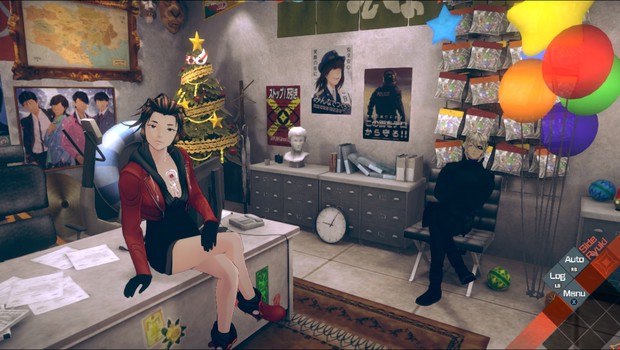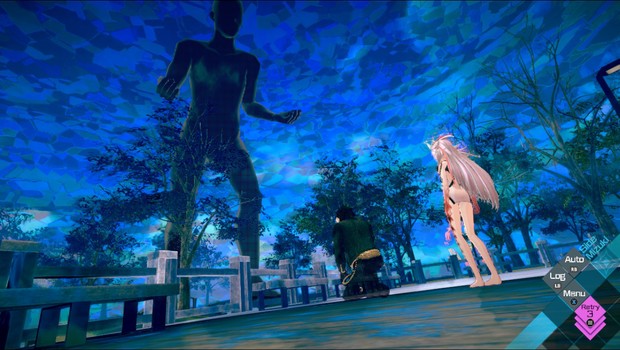AI: The Somnium Files – nirvanA Initiative review – Spike Chunsoft's sequel is a tale of two halves

- 2 Comments
I have been a fan of Kotaro Uchikoshi ever since the dark and violent escape-room visual novel Nine Hours, Nine Persons, Nine Doors. In the years since, we’ve seen him and his team at Spike Chunsoft release a number of other games in a similar vein, expanding what became known as the Nonary Games to a full trilogy before creating the world and characters of AI: The Somnium Files in 2019. With the release of its sequel, nirvanA Initiative, Uchikoshi gives us another dark murder mystery with a surprising amount of unapologetic whimsy. This one goes perhaps a bit too far off the rails in an ending twist that just feels clunky and unwieldy rather than clever and satisfying, but until then it manages to hit all the same highs of its predecessor.
While nirvanA Initiative is a sequel, it does not require or even expect you to have played the first Somnium Files. In fact, the game’s opening scene poses a trivia question to establish your familiarity with the Cyclops Serial Killings, removing some spoilery references from the upcoming narrative if you are unable to answer. Even though I played the previous game, I couldn’t recall the specific fact needed (like many of this game’s puzzle solutions, you have to spell the answer out using an in-game keyboard, so no multiple choice here), but this didn’t impede my enjoyment in the slightest.
Still, those who have already spent time with special agent Kaname Date, his adopted daughter Mizuki, his AI partner Aiba, and the rest of the gang will be happy to see that nearly all of the original game’s characters are back for the second outing. In several cases, familiar faces have been promoted to larger roles, while a few take a step into the background. Joining them are a bevy of new characters to get to know, including the newest member of the Advanced Brain Investigation Squad (ABIS, for short), detective Ryuki, and his AI eyeball Tama, complete with a bombshell humanoid holographic appearance and a larger-than-life bossy personality. Other notable new cast members include Lien, the ex-con with a heart of gold, and Gen, the hulking proprietor of a local eatery who keeps his face perpetually concealed under a mask.

Much like its predecessor (as well as Uchikoshi’s three Nonary Games titles), nirvanA Initiative’s varied and well-fleshed-out characters are an absolute triumph. From their colorful and memorable anime-inspired visual designs to their pronounced personalities (given infinitely more weight by the great performances turned in by the American voice actors once again), I grew to absolutely adore the whole crew. Especially during the game’s final few hours, when the plot was beginning to leave me nonplussed and at least a little frustrated (more on that later), the sheer vibrancy of the characters helped me look past any shortcomings and still feel a genuine sense of impending loss that my time together with them was coming to an end.
Things certainly start out in an intriguing way with a pair of chilling discoveries made six years apart: a single dead body, cut into two halves, perfectly sliced down the middle from top to bottom. Unusual, yes. Cruel even. But what’s truly baffling is that the second half shows no signs of aging or decomposition, which should be impossible this many years later. Dubbed the Half-Body killings (or “HB” for short), this initial case leads to further mysteries as more body halves begin piling up.
The large time gap between the two grisly discoveries is the catalyst for the story being split into (initially) two timelines, with further branches added later down the line. Ryuki, whom players are introduced to for the first time, heads up the initial investigation of the first half-body, while six years later an older (if not necessarily more mature) Mizuki returns to lead her own foray into the HB case, having now become a full-fledged member of ABIS. The concept of a dual-protagonist, multiple-timeline serial killer mystery is an enticing one, and Uchikoshi’s weaving of many spiritual themes – particularly Hindu and Buddhist principles like nirvana, chakras, and moksha – into the narrative adds a taste of the exotic to those less accustomed to such concepts. Not to mention the intrigue of a murderer able to bridge so many years seemingly without effort, leaving evidence that suggests the involvement of time travel, however implausible that sounds.
These ingredients would have made for a tasty meal for any fan of supernatural thrillers all on their own. But Uchikoshi has never been one to serve up a dish without a healthy dose of subverted expectations on the side, and this is where nirvanA Initiative kind of jumped the shark for me. I imagine it’s quite difficult to draw the line between fantastical and outright impossible when attempting to work a time-travel angle into a detective thriller, but the resolution decided on here smacks too much of a cheap cop-out. Without spoiling anything, it's the players who end up being the ones missing a crucial piece to the puzzle all along, leaving us more in the dark than the in-game characters. It hardly seemed worth the effort, once the final reveal had been made, to mentally retrace dozens of hours’ worth of plot just to comprehend how thoroughly I’d been made a fool of. If anything, it felt unfair and far less satisfying than a simpler, more straightforward murder mystery would have probably been.

On the gameplay front, not much has changed since the first Somnium Files. Ryuki and Mizuki both visit (and revisit) the same one or two dozen locations, including many recycled ones, to discover clues or conduct interviews as the plot unfolds. Apart from the ABIS headquarters, returning players will recognize Mama’s bar, Matsushita diner, the Lemniscate talent agency, and the Kumakura yakuza office, amongst others. There are plenty of new locales as well, such as the city’s sports stadium, the Aioen orphanage, and the Horadori Institute of Genetics. Sometimes the objective you’re trying to accomplish is clear, while other times it’s a nebulous “gain new information” and you’re left to poke around places available on the city map until you stumble upon the right event that presses the story on.
It all handles the same as before, whether using a mouse/keyboard combination or plugging in a gamepad. The first-person exploration sections place you in a fixed location, unable to physically move, with an on-screen cursor swiveling the camera around you. Somnium scenes and virtual reality investigations are portrayed in third-person, letting you actually move your protagonist around the gameworld. For those with the required patience, there is some fun to be had in clicking all available hotspots in an environment each time you visit it, as some flavor text changes over the course of the game in sometimes funny, sometimes lewd, always unpredictable ways. This does make the constant backtracking to the same places feel rather grindy, however, and grows a bit long in the tooth over the thirty-plus hours it takes to reach the end (a thorough playthrough will clock in closer to the forty-hour mark).
Aiba and Tama, the self-aware AIs installed in Mizuki and Riyuki’s left eyesockets, respectively, have a new feature this time around – called Wink Psync – that lets them briefly delve into the mind of one person per scene, listening in on their internal thoughts for a few seconds before the battery power runs out. Of course, the series’ major conceit of Psyncing – full-fledged puzzle levels playing out within the somnium dream state of an individual – makes a return as well, each time somebody doesn’t want to or isn’t able to answer the investigators’ questions, which happens pretty much once per chapter.

The somnium sections were one of my least favorite aspects of the previous title, and not much has changed. Being set within a person’s mind, they fully abandon all sense and logic, meaning that solving puzzles is often reliant on trial and error. Worse, the six-minute time limit is back again as well, with any action performed in the somnium, including simply moving around, ticking down a timer that results in a fail state if it reaches zero, forcing the whole section to be restarted or a specific checkpoint (including any time penalties already accrued) to be reloaded.
Generally speaking, the object of each somnium is the same: the person whose mind is being delved into is in possession of a vital clue to the investigation, but is unable or unwilling to share it. Aiba and Tama, under Mizuki and Riyuki’s guidance, must break down a number of mental locks to uncover the needed info. It’s the specific content they face within the somnia that changes from person to person. One individual is suffering from a strained relationship with their father that must be resolved, while another’s mind is burdened by intense guilt that has to be eased. Occasionally a somnium will take on a thematic bent, such as a TV quiz show that must be won or an off-brand version of a Pokémon video game. Unfortunately, puzzle solutions are often unpredictable (they take place in dreams, after all), and are a far cry from the logical escape-room simulations found in Uchikoshi’s earlier work.
There is a brand new gameplay element added this time around, in which Aiba or Tama project a VR recreation of a crime scene in order to allow Mizuki or Riyuki to thoroughly inspect it. These sections, much like the somnium scenes, give you full mobility within a 3D space to run around and interact with objects, though this time without any imposed time limit or dream state rules. After carefully inspecting their surroundings, Mizuki and Riyuki must then put themselves into the mind of the killer and recreate the events as they presumably happened, all while being hilariously berated by Aiba and Tama, who assume the role of a film director dealing with a troublesome actor on a movie set.
A handful of question-and-answer puzzles are scattered about as well, both in the waking world and in somnia. The game poses a question that requires an answer to be typed in, meaning that guessing is usually next to impossible (though I somehow managed to bumble my way through one of these anyway). Some of these queries are based on the investigation at hand, but there are others that involve deciphering a code or doing some mental number gymnastics. The game may provide a hint or two if you’re particularly unsuccessful, but at some point hints run dry and you either come up with the correct response or remain stuck at these puzzles indefinitely. When they appear in a somnium, additional time penalties are even assessed each time you have to reinitialize the puzzle after consulting the in-game text log.
Veterans of Uchikoshi’s work will also be familiar with certain points at which the narrative splits. A few times this occurs after you’re asked a puzzle question to which you’ve not yet learned the answer. The timeline then splits, and accessing the new branch will require gleaning the required information elsewhere, usually further down the timeline. The previous game made liberal use of these branching pathways, which made it harder to follow the already convoluted plot. For me, keeping track of a story like this, with its large cast of characters with interconnected relationships across various timelines, is more of a chore than it’s worth. Thankfully, there seem to be fewer of these moments in nirvanA Initiative than we’ve seen in the past, with only minimal jumping back and forth required to see them all through to the end.
While the HB case is pretty grim and grotesque, there are a good number of tonal shifts woven throughout the narrative, at times taking the form of grandiose martial arts action set pieces, and at other times a fully choreographed musical routine. On paper this might sound jarring, but it works surprisingly well and is incredibly entertaining in practice. You can simply sit back and enjoy the musical interludes, though the action sequences do require some (light) Quick Time Event button inputs that can simply be retried if failed.
The game is presented using the same graphics engine as the first one, with colorful animated characters and otherwise mostly static surroundings. Outside of the action scenes and dance routines, animation is used sparingly, generally reserved for 3D exploration sections and some simple character movements. Just like environments and characters from the first game are reused, so too are familiar musical themes that returning players will recognize. Original new compositions fit right in, though nothing remotely as catchy as the original J-Pop song (accompanied by an actual animated dance routine performed by the characters) prominently featured throughout the game.
Final Verdict
AI: The Somnium Files – nirvanA Initiative is something of a conundrum, in more ways than one. It showcases all the witty writing and lovable character designs of its predecessor, and really leans into the off-kilter humor that made the original entry so charming. But I wish the somnium investigations behaved like more traditional logic puzzles, or else were absent entirely. Moreover, while Uchikoshi has never been one for restraint, here he goes perhaps a bridge too far with an outlandish plot twist that seems more designed to be a joke at the player’s expense than anything that actually impacts the characters. I’m glad I played the game and I certainly cherish the time I got to spend with such endearing characters once again. But if another sequel is planned, I would welcome a “less is more” approach next time, relying more on the intrigue innately stemming from a juicy murder mystery than any outlandish “gotcha!” moment that only detracts from the many things the series does best.
Hot take
The unfixed flaws have now overstayed their welcome, but Kotaro Uchikoshi once again keeps his foot on the pedal, ensuring a sequel with oodles of loveable charm and fun that is very much in line with its predecessor.
Pros
- Colorful and varied cast consisting of new and old faces alike
- Outstanding writing, localization, and voice acting
- Adult humor and corny musical numbers complement each other well
- A truly puzzling murder mystery plot to slowly unfold
Cons
- Timed somnium sections still ignore sense and logic
- Plot twist shocker results more in unfair frustration than genuine surprise
Pascal played AI: The Somnium Files – nirvanA Initiative on PC using a review code provided by the game's publisher.

- Advertisement
- Help support AGH by advertising with us











2 Comments
Want to join the discussion? Leave a comment as guest, sign in or register.
Ah, what a shame to hear the somnium sections weren't fixed. Ah well.
Reply
The implication behind the wording of those sections being "not fixed" kind of says it all, doesn't it?
Reply
Leave a comment